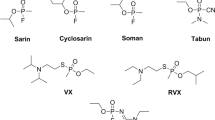Abstract
The effects of a synthetic 5,6-dihydro-alpha-kava-pyrone (+)-methysticin on voltage-operated Na+ channels was studied in isolated whole-cell patch-clampedCA1 hippocampal neurons. Within a concentration range of 1–400 µM, (+)-methysticin induced a rapid and partly reversible dose-dependent reduction of the peak amplitude of Na+ current. Shifts of the holding membrane potential toward more positive values considerably enhanced the blocking effect. The efficiency of this block showed no dependence on the frequency of stimulation. In addition, (+)-methysticin shifted a steady-state inactivation curve toward more negative membrane potentials, accelerated the time course of fast inactivation, and slowed down the recovery from inactivation. From the above findings, the voltage dependence of (+)-methysticin effect can be accounted for by an increased portion of inactivated Na+ channels. Thus, the effect of (+)-methysticin on voltage-operated Na+ channels is associated with decreased excitability of nerve cell membranes. This suggests that this drug is capable of suppressing seizure activity of different genesis, including epileptic seizures. More effective action of (+)-methysticin on depolarized neuronal membrane prompts its possible application for therapeutic purposes in pathological disorders accompanied by depolarization of neurons in damaged foci, in particular in the case of cerebral ischemia.
Similar content being viewed by others
References
V. Lebot, M. Merlin, and L. Lindstrom,Kava The Pacific Drug, Yale Univ. Press, New Haven (1992).
Y. N. Singh, “Kava: an overview,”J. Ethnopharmacol., 37, 13–45 (1992).
H. J. Meyer, “Pharmacology of kava,” inEthnopharmacologic Search for Psychoactive Drugs, D. H. Efron, B. Holmstedt, and N. S. Kline (eds.), Raven Press, New York (1979), pp. 133–140.
D. Schmitz, C. L. Zhang, and S. S. Chatterjee, “Effects of methysticin on three different models of seizure-like events studied in rat hippocampal and entorhinal cortex slices,”Naunyn-Schmiedeberg's Arch. Pharmacol.,351, 348–355 (1995).
C. C. Rfiffer, H. B. Mutphree, and L. Goldstein, “Effect of kava in normal subjects and patients,” in:Ethnopharmacologic Search for Psychoactive Drugs, D. H. Efron, B. Holmstedt, and N. S. Kline (eds.), Raven Press, New York (1979), pp. 155–161.
J. Gleitz, A. Beile, and T. Peters, “(±)-Kavain inhibits veratridine-activated voltage-dependent Na+-channels in synaptosomes prepared from rat cerebral cortex,”Neuropharmacology,34, 1133–1138 (1995).
J. Gleitz, A. Beile, and T. Peters, “(±)-Kavain inhibits veratridine- and KCl-induced increase in intracellular Ca2+ and glutamate-release of rat cerebrocortical synaptosomes,”Neuropharmacology,35, 179–186 (1996).
W. A. Caterall, “Common modes of drug action on Na+ channels: local anesthetics, anti-arrhythmics and anticonvulsants,”TIPS,8, 57–65 (1987).
C. P. Taylor and B. S. Meldrum, “Na+-channels as targets for neuroprotective drugs,”TIPS,16, 309–316 (1995).
C. Backhau and J. Kriglstein, “Extract of kava (Piper methysticum) and its methysticin constituents protect brain tissue against ischemic damage in rodents,”Eur. J. Pharmacol.,215, 265–269 (1992).
V. A. Panchenko, J. Pintor, A. Ya. Tsyndrenko, et al., “Diadenosine polyphosphates selectively potentiate N-type Ca2+-channels in rat central neurons,”Neuroscience,70, No. 2, 353–360 (1996).
O. A. Kryshtal' (Krishtal), S. M. Marchenko, and V. I. Pidoplichko, “Receptor for ATP in membrane of mammalian sensory neurones,”Neurosci. Lett.,35, 41–45 (1983).
N. I. Kiskin, I. V. Chizhmakov, A. Ya. Tsyndrenko, et al., “R56865 and flunarizine as Na+-channel blockers in isolated Purkinje neurons of rat cerebellum,”Neuroscience,54, No. 3, 575–585 (1993).
A. L. Hodgkin and A. F. Huxley, “The dual effect of membrane potential on sodium conductance in the giant axon ofLoligo,”J. Physiol.,116, 497–506 (1952).
B. Hille, “Local anesthetics: hydrophilic and hydrophobic pathways for the drug-receptor reaction,”J. Gen. Physiol.,69, 497–515 (1977).
C. Quan, W. M. Mok, and G. K. Wang, “Use-dependent inhibition of Na+ currents by benzocaine homologs,”Biophys. J.,70, Jan., 194–201 (1996).
C.-C. Kuo and B. P. Bean, “Na+ channels must deactivate to recover from inactivation,”Neuron,12, Apr., 819–829 (1994).
J. Urenjak and T. P. Obrenovitch, “Pharmacological modulation of voltage-gated Na+ channels: a rational and effective strategy against ishemic brain damage,”Pharmacol. Rev.,48, No. 1, 21–67 (1996).
M. Lauritzen, “Pathophysiology of the migraine aura: the spreading depression theory,”Brain,117, 199–210 (1994).
Author information
Authors and Affiliations
Additional information
Neirofiziologiya/Neurophysiology, Vol. 28, No. 4/5, pp. 179–185, July–October, 1996.
Rights and permissions
About this article
Cite this article
Magura, E.I., Ostrovskaya, O.I., Kopanitsa, M.V. et al. Down-modulation induced block of voltage-operated Na+ channels in ratCA1 hippocampal neurons by (+)-methysticin. Neurophysiology 28, 140–144 (1996). https://doi.org/10.1007/BF02262775
Received:
Issue Date:
DOI: https://doi.org/10.1007/BF02262775




